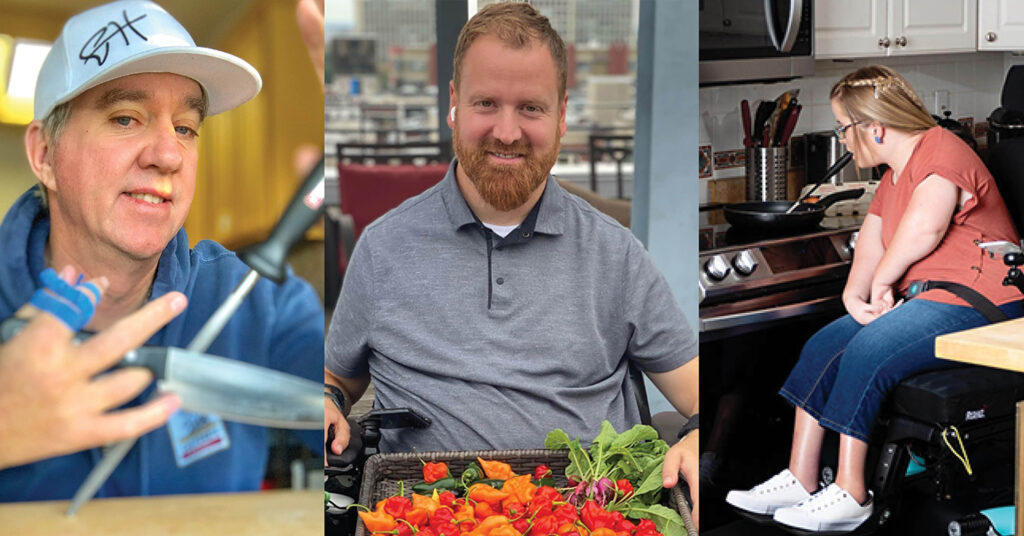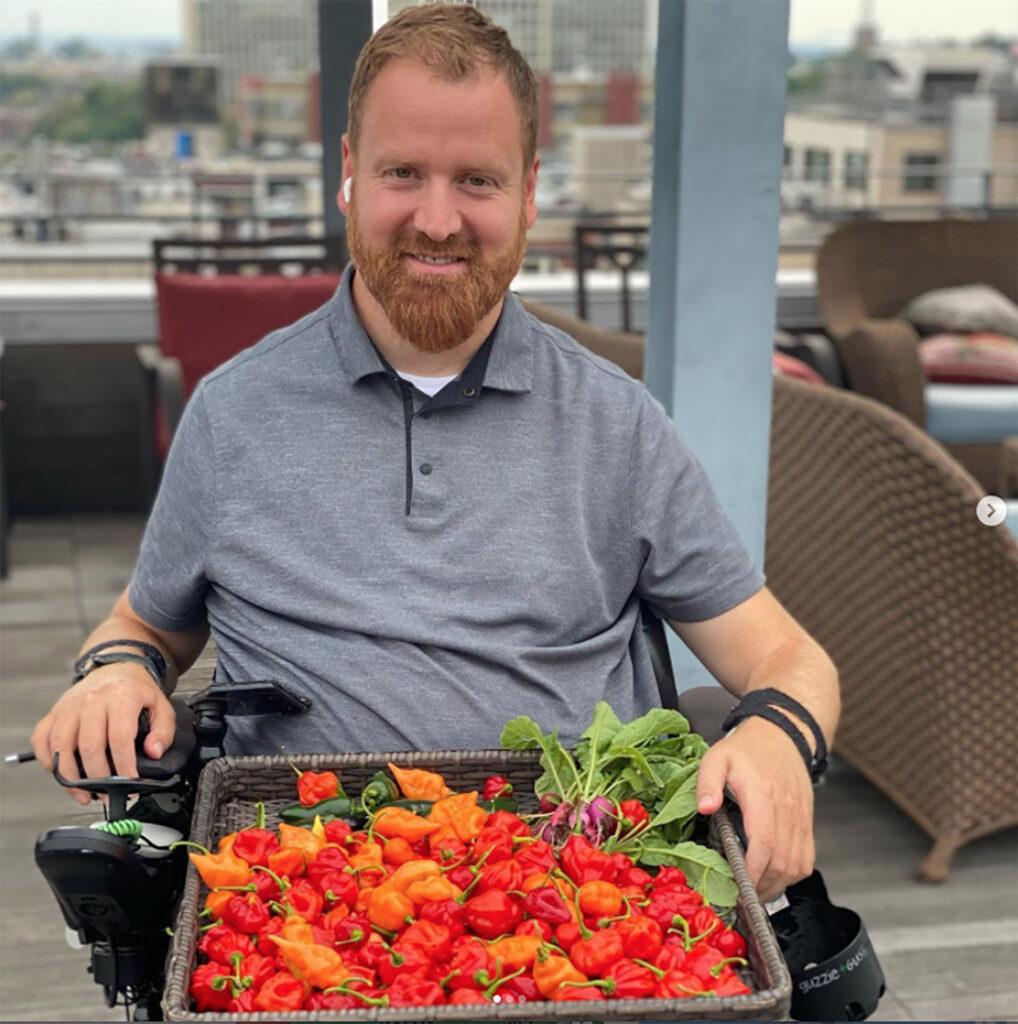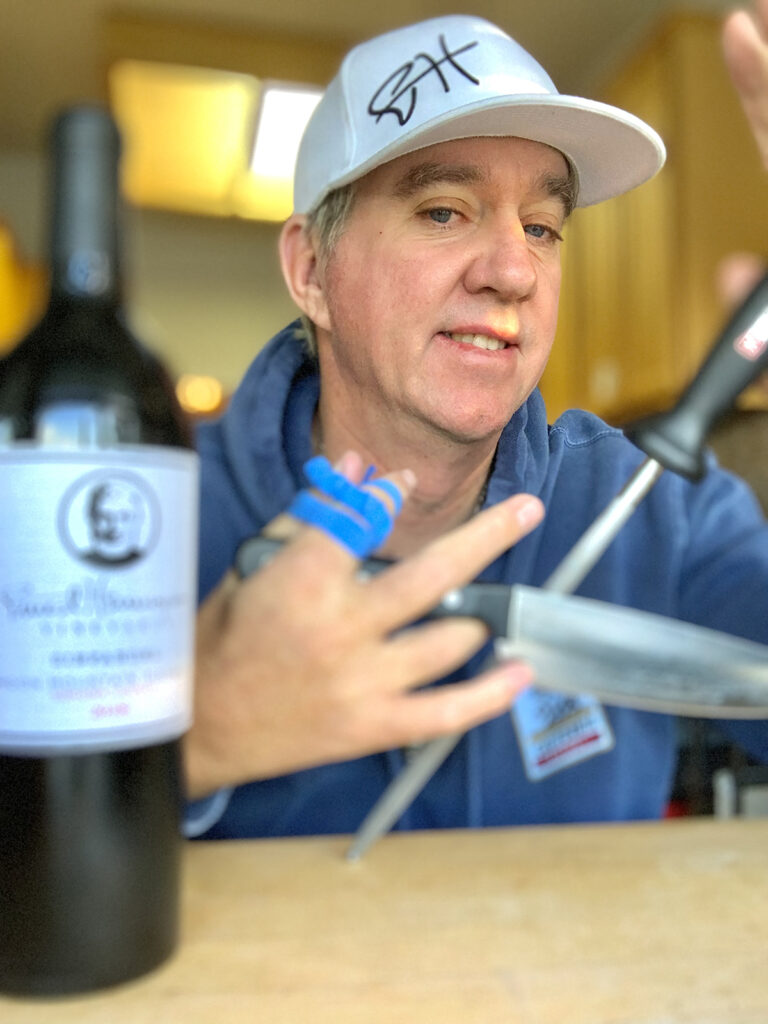
While preparing for a gender reveal party, Sara Gaver realized her cupcakes had a superpower. “We threw them on the floor, and they bounced like balls,” she says, blaming the amount of food coloring needed to turn her creations an exact shade of blue and pink. Since she couldn’t serve them, she purchased a new, unfrosted batch to decorate and pass off as her own.
Food coloring mishap aside, Gaver found success in the kitchen by confidently embracing the body she has, instead of worrying about what she is unable to do. With limited use of her hands — her joints and muscles are fused because of arthrogryposis — she learned to rely on her mouth for cooking.
Her unique culinary technique caught the attention of Permobil, which asked her to star in a commercial for its Voice Assist app. One of the promotional photos shows her holding a spatula in her mouth to flip eggs.

Gaver jokes that she learned to cook when she started living independently and realized she couldn’t order takeout every night. But celebrated Philadelphia chef Eli Kulp got his first taste of the culinary world when he was 14. He washed dishes at a small, sit-down restaurant in his hometown of Mossyrock, Washington, transitioned to prep work and graduated from the Culinary Institute of America in 2005.
Kulp was paralyzed in an Amtrak crash in 2015 while traveling home to Philadelphia from New York, where he was launching his new restaurant, High Street on Hudson. The wreck damaged his spinal cord at C4-5, and he lost the ability to cook with his hands. Now a High Street Hospitality Group chef partner, he kicks off his weekly meal planning at a local farmers market. “I get the ideas running in my head, and we go home and start looking at each item. Then we say, ‘OK, we’re going to cook this with the lamb. We’re going to add this. We’re going to roast this piece. We’re going to grill that.’”
Kitchen Confidence
Kulp’s advice for an inexperienced cook is straightforward — learn the necessary culinary terms to tell an assistant what you need. “If you have minimal ability to get in the kitchen or hold a knife or cut or chop or sauté or whatever, you have to rely on somebody to communicate that with, and you have to develop the language between the two of you,” he says.
Agreeing on a vocabulary is a great place to start, but eventually, you must get into the kitchen, and Kulp knows this might be hard for some. “One of the challenges people with disabilities have is the fact that nothing’s going to come easy,” he says. “You just have to do it and get used to it, as painful and frustrating as the first few times might be.”
He recommends searching YouTube for inspiration. While there, you might come across Brent Poppen’s “Cooking with a Quadriplegic” videos.

A two-time Paralympian in wheelchair rugby and tennis, Poppen now works as a rehab counselor at Children’s Hospital in Fresno, California. Paralyzed in a wrestling accident as a teenager, he dedicates his life to showing newly injured children that using a wheelchair is not the limitation they might perceive it to be. “They don’t always believe it until somebody like me is able to represent it to them and show them,” he says.
It became important to Poppen to cook well to prove to the children that they could do things they or their families may have thought they’d never do again. “So, if the kids could cook a meal for themselves, then they could wash the dishes. If they could wash the dishes, they could do the laundry. If they could do the laundry, they could go to school.”
Poppen makes it clear that he’s a quadriplegic in his video titles so that anyone watching can understand his limitations. He calls cooking a brick in the “wall of independence” wheelchair users need to build and suggests people who feel afraid to get into the kitchen start with simple foods they enjoy eating.
“Simple” is key there. Even the biggest fan of pasta isn’t going to enjoy making fresh linguini if they haven’t honed the skill they need to make it an enjoyable experience. A box of dried pasta is fine to start with.
Tips, Tricks and Tools
Most kitchens aren’t wheelchair accessible. So, once you have the confidence to try cooking, you’ll need as many tricks as possible to help turn your kitchen into a more accessible space.

Gaver compensates for her kitchen’s small size and general inaccessibility by choosing her tools well. She relies on her mouth stick and seeks out lightweight appliances she can grip with her teeth. “I picked a few appliances that I really like, like the Crockpot, the coffee pot — because I live off of coffee — and the microwave,” she says. “I placed a little table outside the kitchen with those tools on it at a level that I could reach so that I could do a few things here and there just to kind of build up my skills.”
Her pots have long handles, and she uses a “12-in-one chopper” to slice or dice ingredients into her desired shapes. She also buys groceries online and gets precut items whenever possible.
Poppen enjoys cooking, and he and his wife love to entertain, so a friend built him a prep area that’s lower than a standard countertop, with space underneath for his feet. He also has another clever hack ready.
“Have your friends over,” he says. “Open a bottle of wine and make an event out of cooking the meal. That way, your guests can help with the prep tasks that are hardest for you to do. It’s important not to over-complicate the meal just because you have sous chefs available, but it will add a unique twist to the typical dinner party.”
Accessible Cooking Hopes
Poppen loves to make cooking an all-day affair. “My favorite dishes to make are the dishes that take a couple hours to simmer on the stove,” he says. “Whether it’s a homemade marinara or a sausage and vegetable soup, I like something I can start and tinker with and taste throughout the morning or throughout the day. It makes the house smell good, and it’ll be ready to eat a couple hours later.”
Gaver is an artist and loves the different colors of a good vegetable stir-fry with teriyaki sauce. “The different colors are so fun to play with in the kitchen and then stirring them around in the pot,” she says. “It’s one of those only meals that I literally can do everything and I don’t need any assistance with any part of it, so it’s one of my favorite things to make.”
As far as what’s on the menu for the future of accessible cooking, Kulp hopes that people with disabilities continue to get exposure to professional kitchens. He’d like to see building developers create residential kitchens that have “a universal design where they take into account people that may be in wheelchairs,” because getting into kitchens is such a big step for wheelchair users right now.
Poppen would love to collaborate on an easier-to-hold knife since currently, he binds two of his fingers together with a hair tie so he can hold the handle. He’d also love motorized oven racks to help him get food out of the oven easier.
Gaver wants buttons on the front of her appliances like the big ones on her stove and would also like motorized shelves to make reaching her utensils easier. But even without these tools, she says cooking “gives me my space to have a little bit of creativity, but also be able just to have that time to do something for myself. A lot of times, those of us with disabilities feel like there’s a lot of things we can’t do, so cooking gives me that little bit of motivation and empowerment to take care of myself.”
We all deserve that boost of confidence. So, the next time you find yourself with an empty stomach and an open mind, pull up that YouTube video, open that cookbook, root through those cabinets, and give cooking a try.
Support New MobilityWait! Before you wander off to other parts of the internet, please consider supporting New Mobility. For more than three decades, New Mobility has published groundbreaking content for active wheelchair users. We share practical advice from wheelchair users across the country, review life-changing technology and demand equity in healthcare, travel and all facets of life. But none of this is cheap, easy or profitable. Your support helps us give wheelchair users the resources to build a fulfilling life. |


I had my kitchen remodeled so I could cook. I love to cook and couldn’t do it in my old kitchen. I had all the lower cabinets taken out and had a custom-built counter put in. It wasn’t expensive too. I then sold my stove and oven and bought a tabletop set of burners and a tabletop oven. I also purchased a large drop sink for the counter. Now I can freely cook what ever I want!